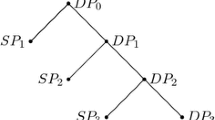Abstract
The Minimum Capacity s-t Cut Problem (MinCut) is an intensively studied problem in combinatorial optimization. A natural extension is the problem of choosing a minimum capacity s-t cut when arc capacities are unknown but confined to known intervals. This motivates the Robust Minimum Capacity s-t Cut Problem (RobuCut), which has applications such as open-pit mining and project scheduling. In this paper, we show how RobuCut can be reduced to solving a sequence of maximum flow problems and provide an efficient algorithm for rapidly solving this sequence of problems. We demonstrate that our algorithm solves instances of RobuCut in seconds that would require hours if a standard maximum flow solver is iteratively used as a black-box subroutine.
Similar content being viewed by others
References
Ahuja, R. K., Magnanti, T. L., & Orlin, J. B. (1993). Network flows: theory, algorithms and applications. New York: Prentice Hall.
Altner, D. S. (2008). Advancements on problems involving maximum flows. Ph.D. Thesis, Georgia Institute of Technology, Atlanta, Georgia.
Altner, D. S., & Ergun, Ö. (2008). Rapidly solving an online sequence of maximum flow problems with applications to computing robust minimum cuts. In L. Perron & M. A. Trick (Eds.), Lecture Notes in Computer Science: Vol. 5015. Integration of AI and OR techniques in constraint programming for combinatorial optimization problems. Berlin: Springer.
Atamtürk, A., & Zhang, M. (2007). Two-stage robust network flow and design under demand uncertainty. Operations Research, 55, 662–673.
Ben-Tal, A., & Nemirovski, A. (1998). Robust convex optimization. Mathematics of Operations Research, 23, 769–805.
Bertsimas, D., & Sim, M. (2003). Robust discrete optimization and network flows. Mathematical Programming, 98, 49–71.
Chaerani, D., & Roos, C. (2006). Modelling some robust design problems via conic optimization. Operations Research Proceedings, 209–214.
Cheriyan, J., & Melhorn, K. (1999). An analysis of the highest-level selection rule in the preflow-push max-flow algorithm. Information Processing Letters, 69, 239–242.
Cherkassky, B. V., & Goldberg, A. V. (1994). On implementing the push-relabel method for the maximum flow problem. Algorithmica, 19, 390–410.
Ford, L. R., & Fulkerson, D. R. (1956). Maximal flow through a network. Canadian Journal of Mathematics, 8, 399–404.
Goldberg, A. V. (2010). Andrew V. Goldberg’s network optimization library. http://avglab.com/andrew/soft.html.
Goldberg, A. V., & Rao, S. (1998). Beyond the flow decomposition barrier. Journal of Associated Computing Machinery, 45, 783–797.
Goldberg, A. V., & Tarjan, R. E. (1988). A new approach to the maximum flow problem. Journal of Associated Computing Machinery, 35, 921–940.
Govindaraju, V. (2008). Professor of computer science and engineering, University of Buffalo, personal communication.
Harris, T. E., & Ross, F. S. (1955). Fundamentals of a method for evaluating rail network capacities. Research Memorandum RM-1573, The RAND Corporation, Santa Monica, CA.
Hochbaum, D. S., & Chen, A. (2000). Improved planning for the open-pit mining problem. Operations Research, 48, 894–914.
Matsuoka, Y., & Fujishige, S. (2004). Practical efficiency of maximum flow algorithms using maximum adjacency (MA) orderings. Technical Report METR 2004-27, University of Tokyo.
Möhring, R. H., Schulz, A. S., Stork, F., & Uetz, M. (2003). Solving project scheduling problems by minimum cut computations. Management Science, 49, 330–350.
Monkhouse, P. H. L., & Yeates, G. (2005). Beyond naive optimization. AUSIMM Spectrum Series, 14, 3–8.
Ordóñez, F., & Zhao, J. (2007). Robust capacity expansion of network flows. Networks, 50, 136–145.
Régin, J. C. (1994). A filtering algorithm for constraints of difference in constraint satisfaction problems. In Proceedings of the twelfth national conference on artificial intelligence, vol. 1, pp. 362–367.
Royset, J. O., & Wood, R. K. (2007). Solving the bi-objective maximum flow network interdiction problem. INFORMS Journal on Computing, 19, 175–184.
Stone, H. S. (1977). Multiprocessor scheduling with the aid of network flow algorithms. IEEE Transactions on Software Engineering, 3, 85–93.
Strickland, D. M., Barnes, E., & Sokol, J. S. (2005). Optimal protein structure alignment using maximum cliques. Operations Research, 53, 389–402.
Author information
Authors and Affiliations
Corresponding author
Rights and permissions
About this article
Cite this article
Altner, D.S., Ergun, Ö. Rapidly computing robust minimum capacity s-t cuts: a case study in solving a sequence of maximum flow problems. Ann Oper Res 184, 3–26 (2011). https://doi.org/10.1007/s10479-010-0730-1
Published:
Issue Date:
DOI: https://doi.org/10.1007/s10479-010-0730-1




